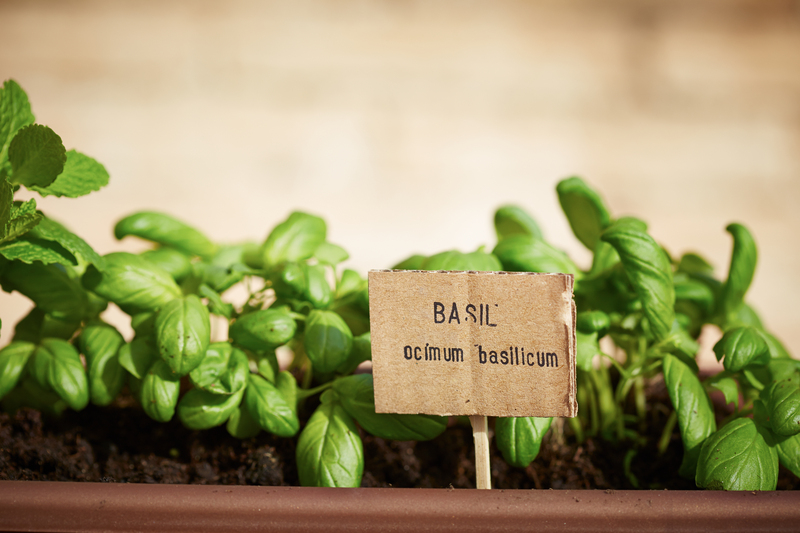Elevate Your Orchid Care: Expert Tips Enclosed
Posted on 13/09/2025
Elevate Your Orchid Care: Expert Tips Enclosed
Orchids captivate with their stunning eccentric blooms and intricate beauty. Yet, raising these unique plants can often seem daunting, especially for beginners. Do you dream of vibrant, thriving orchids at home? Unlocking the secrets of proper orchid care is the first step to enjoying flourishing flowers year after year. This comprehensive guide reveals practical, expert orchid care tips--from watering routines to optimal lighting, troubleshooting, and even pro repotting advice. Read on to elevate your orchid cultivation and embrace orchid care success!
Understanding Your Orchid: The Foundation of Exceptional Care
Before you begin tending to your orchid, it's crucial to understand its unique needs and natural habitat. With over 25,000 species, orchids come in many shapes, sizes, and environmental requirements. Catering your care routine to your particular type is vital for success.
Identifying Common Orchid Varieties
Some orchid types are especially common among enthusiasts and each variety requires slightly different conditions:
- Phalaenopsis (Moth Orchids): Popular for their beginner-friendly resilience and long-blooming flowers.
- Cattleya Orchids: Revered for their large, fragrant blossoms and vibrant colors.
- Dendrobium Orchids: Known for their striking, slender blooms and sturdy stems.
- Oncidium Orchids: Famous for delicate, dancing "spray" flowers.
- Paphiopedilum (Lady Slipper): Unique pouch-shaped flowers ideal for intermediate growers.
Tip: Identify your orchid's species by checking its foliage shape, roots, care tag, or flowers. Knowing your orchid type helps personalize and elevate orchid care results.

Key Components of Optimal Orchid Care
Let's break down what it takes to keep orchids happy and healthy. The secret lies in mimicking their native environment. Focus on four pillars: light, watering, temperature, and humidity.
Essential Orchid Lighting Requirements
Light is perhaps the most critical orchid care factor. Most orchids thrive in bright, indirect sunlight. Too little light results in weak growth and scarce flowering. Direct sunlight, on the other hand, can burn delicate orchid leaves.
- For South or West-Facing Windows: Place orchids behind sheer curtains to diffuse light.
- East-Facing Windows: Ideal for morning sun--perfect for Phalaenopsis and Paphiopedilum varieties.
- Artificial Grow Lights: Provide consistent, customizable lighting where natural options are insufficient or during short winter days.
Leaf color serves as a handy indicator:
Healthy orchids generally have light to medium green leaves. Very dark green leaves may signal insufficient light, while yellowing or reddish tints point to sunburn or overexposure.
The Art of Watering Orchids
Mastering a watering routine is fundamental for successful orchid maintenance. Overwatering is the most common cause of orchid root rot and declining health. Here's how to get it right:
- Water only when media is nearly dry. Stick your finger into the pot or use a wooden skewer--if it feels dry an inch down, it's time to water.
- Always use tepid, non-chlorinated water. Room temperature rainwater or distilled water is best for orchids.
- Water thoroughly. Allow water to drain freely from the bottom--never let orchids sit in stagnant water!
- Empty decorative pots or saucers of excess water to prevent root rot.
- Avoid watering the foliage or crown directly. Water trapped here can cause deadly crown rot.
Frequency varies by season: During active growth (spring and summer), orchids may need water once a week. In winter, wait 10-14 days between waterings. If unsure, underwater rather than overwater, as some drought is less damaging than root suffocation.
Ideal Temperature & Humidity for Orchids
Orchids crave stability. In their native jungles, temperatures stay in the 65-80?F (18-27?C) range. Try to mimic this at home:
- Daytime temperatures: 70-80?F (21-27?C)
- Night temperatures: 60-65?F (16-18?C)
Orchid humidity levels should stay between 40% and 60%. If your home's air is dry (especially in winter), increase humidity by:
- Grouping plants together. (Creates a mini-microclimate)
- Using a humidity tray (a shallow dish filled with pebbles and water underneath the pot)
- Running a room humidifier near your orchids.
Pro Tip: Boost airflow around orchids while maintaining humidity. Gentle fan use prevents fungal diseases and encourages robust growth.
Best Orchid Potting Media and Repotting Guidelines
Orchid roots need more air than those of traditional houseplants. Standard soil suffocates and rots them. Instead, choose a chunky, breathable media:
- Bark mix: The classic. Suits most orchids, especially epiphytic types like Phalaenopsis and Cattleya.
- Sphagnum moss: Retains moisture--great for smaller orchids or those in drier environments.
- Coconut husk chips: Sustainable, airy, and moisture-retentive.
- Perlite or charcoal: Enhance drainage and air movement in custom blends.
When and How to Repot Orchids
Repot every 1-2 years or when roots become crowded, the potting mix breaks down, or after flowering. To repot:
- Gently remove the orchid from its container, shaking off loose media.
- Trim dead or mushy roots with sterile scissors.
- Select a slightly larger orchid pot with excellent drainage.
- Fill pot with fresh orchid mix, centering the plant and covering roots but not leaves/crown.
- Water lightly after repotting and wait a week before resuming full watering to allow roots to adjust.
Expertly repotting your orchid can dramatically improve its growth and longevity--don't skip this step!
Mastering Orchid Fertilizing Routines
Orchids require less fertilizer than you might think. Overfeeding leads to salt buildup and stressed roots. Instead:
- Use a balanced, water-soluble orchid fertilizer (20-20-20 or similar).
- Dilute to half or quarter strength: Less is more for orchids!
- Fertilize every 2-4 weeks during the growing season (spring-summer).
- Reduce to once a month or suspend in winter when growth slows.
- Rinse the potting mix with plain water monthly: Prevents harmful salt buildup in the media.
Expert tip: "Feed weakly, weekly"--this mantra helps avoid overfertilization and keeps your orchid in bloom-ready shape.
Advanced Orchid Care: Expert Tricks for Thriving Blooms
Encouraging Reblooming
Many growers are disappointed when their orchid flowers drop and fail to return. Here's how to encourage your orchid to rebloom:
- After blooms fade: For Phalaenopsis, cut the spike above a node to encourage secondary spikes. For other types, trim the stalk at the base.
- Cool night temperatures for 2-3 weeks (55-60?F/13-16?C) during autumn can trigger new flower spikes.
- Maintain steady feeding and watering routines as new spikes form.
- Provide plenty of bright, indirect light.
Patience pays off! Orchids sometimes take months before reblooming. If you provide optimal conditions, those breathtaking flowers will reappear.
Solving Common Orchid Care Problems
Struggling with health issues? Here are fast solutions to frequent orchid problems:
- Yellowing Leaves: Usually caused by overwatering or old age. Adjust your routine and trim old, yellow leaves at the base.
- Wrinkled Leaves: Signals underwatering or root damage. Check roots--healthy ones are firm and white/green.
- Black/Brown Spots: Could be fungal infection--remove affected leaves and treat with a gentle fungicide.
- No Blooms: Often a sign of too little light or improper feeding. Move to a brighter location and resume regular, diluted fertilization.
- Sticky Leaves: Watch out for pests such as scale or aphids. Remove pests with rubbing alcohol and improve airflow.
Remember: Orchid care is a journey. Pay close attention to your plant's signals for best results.
Seasonal Orchid Care and Long-Term Maintenance
Orchid Care in Winter
Winter can be tough on orchids due to lower light and humidity. To help your plants thrive:
- Move orchids closer to south or east-facing windows.
- Supplement with grow lights if days are short.
- Increase humidity with trays or a humidifier.
- Reduce watering, since growth is slower and less water evaporates.
- Keep your orchid away from cold drafts and heat sources.
Summer Orchid Care Tips
- Watch for overheating near windows--move orchids back from midday sun.
- Mist plants or use additional humidity trays.
- Increase watering as needed, but check potting mix before watering.
- Inspect frequently for insects and treat as needed.
Expert Orchid Care Tips Summary
To elevate your orchid care and cultivate impressive, healthy plants year after year, follow these foundation rules:
- Determine your orchid species for tailored care routines.
- Give orchids bright, indirect light and avoid direct sunburn.
- Water only when the media is dry, and avoid wetting leaves and crown.
- Use special orchid bark or sphagnum moss, not regular soil.
- Maintain steady temperatures (65-80?F) and humidity (40-60%).
- Repot every 1-2 years using fresh, well-draining mix.
- Feed 'weakly, weekly' during growth periods and flush with water regularly.
- Stay vigilant for pests and promptly treat any infestations.
- Encourage reblooming by mimicking seasonal cool nights.

Frequently Asked Questions About Orchid Care
How often should I water my orchid?
Most orchids need watering once a week during active growth and every 10-14 days during winter. Only water when the potting mix is nearly dry--overwatering is the most common mistake!
Why aren't my orchids blooming?
The most common causes are insufficient light, too much fertilizer, or lacking a rest period. Move your plant to a brighter location and follow a "feed weakly, weekly" approach. For some orchids, a cool spell at night in fall is needed for spike formation.
Do orchids need to be misted?
While misting can help increase humidity, it is often insufficient on its own and can lead to fungal problems if water sits on leaves. Prioritize humidity trays or room humidifiers instead.
What is the best fertilizer for orchids?
Choose a balanced, water-soluble fertilizer (such as 20-20-20) specifically formulated for orchids. Always dilute to half or quarter strength. Specialty "bloom booster" formulas can be helpful during spike formation, but are not strictly necessary with good regular care.
Conclusion: Cultivate Confidence & Beauty with Elevated Orchid Care
With these expert orchid care tips at your disposal, you're equipped to nurture thriving, long-lived specimens that will dazzle with breathtaking blooms and captivating foliage season after season.
Whether you're a seasoned orchid fan or a novice seeking to elevate your houseplant game, remember that attentive observation is the secret to mastery. Take time to learn your orchid's preferences. Small changes--like adjusting light, improving watering technique, or upgrading your orchid's pot--can yield spectacular results.
Transform your orchid care today with these time-tested, expert-approved techniques. With patience, your personal orchid oasis awaits!

